b. Institute for Eco-environmental Research of Sanyang Wetland, Wenzhou University, Wenzhou 325014, Zhejiang, China;
c. Institute of Wetland Ecology & Clone Ecology/Zhejiang Provincial Key Laboratory of Plant Evolutionary Ecology and Conservation, Taizhou University, Taizhou 318000, Zhejiang, China
Biological invasions are a serious global problem, reshaping local communities (Wang et al., 2017, 2024; Liu et al., 2023a; Vilà et al., 2024). The intensification of human activities, particularly on land use, has led to severe habitat fragmentation (Haddad et al., 2015; Ma et al., 2023). Fragmented patches, hereafter referred to as fragments, often harbor limited resources, which can adversely affect native species composition and ecological interactions, especially during invasions by alien species (Vila et al., 2011). Identifying the potential drivers of alien species invasions of fragmented landscapes is crucial for predicting which fragments are most vulnerable to biological invasions and providing a basis for prevention and management of these invasions (Zhu et al., 2023).
The equilibrium theory of island biogeography (hereafter, island biogeography theory) predicts that larger and less isolated islands contain more species because they can support larger populations that are less prone to extinction and have a higher immigration rate (MacArthur and Wilson, 1967). However, invasive species frequently possess superior dispersal and resource utilization abilities compared to native species (Liu et al., 2019; Zhang et al., 2023). Thus, it is unknown whether their distribution patterns align with the predictions of island biogeography theory. Some studies have shown that the distribution patterns of native and invasive species richness are governed by similar biogeographic principles (Schmack et al., 2020; Mologni et al., 2021). However, research has revealed that alien plant species favor larger, less isolated islands at higher latitudes and closer to urban areas (Mologni et al., 2021). Similarly, studies on wasps have observed higher abundance of invasive species (e.g., Vespula) on islands settled by humans (Schmack et al., 2020). These findings indicate that human activities influence invasive species distribution, challenging the predictions from island biogeography theory. Thus, it is uncertain whether increasing isolation and decreasing fragment area reduce alien species invasions.
Human activities have profoundly modified many fragmented ecosystems (Russell and Kueffer, 2019), yet their impact on species diversity remains paradoxical (Vellend et al., 2017). Human activities such as land use, habitat transformation, bushmeat hunting, and logging can negatively affect species diversity in fragmented habitats by increasing extinction rates, especially in small fragments and among local endemics or highly specialized species (Russell and Kueffer, 2019; Storch et al., 2022). However, some studies have suggested that human activities can enhance species diversity on islands by species introductions, especially the diversity of herbs (Wohlwend et al., 2021; Liu et al., 2023b). Regardless, it is unclear whether human activity affects invasive and native herbs similarly. Human activities, such as transport, population movement, land-use intensity, and cultivation, may help invasive species to overcome natural barriers and establish themselves in new fragments (Schmack et al., 2020; Wohlwend et al., 2021; Raveloaritiana et al., 2024). Moreover, human activities may alter the relationships that invasive species have with fragment characteristics, making them distinct from those of native species, potentially generating unrelated or non-negative species-isolation relationships (Moody, 2000; Guo, 2014).
Human activities, whether intentionally or unintentionally, contribute to the introduction of invasive species while also increasing local species diversity through the introduction of native species (e.g., cultivation). Extensive research has examined how local species diversity influences the success of invasive species. The biotic resistance hypothesis (Elton, 1958) posits that species-rich native communities are more resistant to biological invasions than less diverse communities. However, studies indicate that this hypothesis is likely to be supported more at smaller spatial scales (e.g., plot scale) and is still under debate (Peng et al., 2019). Similarly, the island susceptibility hypothesis suggests that continents are more resistant to alien species invasions than islands (Jeschke et al., 2018). Since species diversity generally increases with the increase of fragment area, smaller fragments are considered more susceptible to establishment and the ecological impacts of alien species compared to larger ones. Despite this, it remains unclear whether increased local species diversity through artificial cultivation can effectively prevent alien species invasions, and whether larger fragments, due to their richer native species, are indeed more resistant to biological invasions than smaller fragments.
Plant dispersal syndromes also play a crucial role in shaping the relationship of species diversity with habitat area and isolation (Walentowitz et al., 2022). Long-distance dispersal ability is essential for species survival in fragmented landscapes (Bacles et al., 2006). Wind-dispersed (anemochore) and animal-dispersed (zoochore) species are presumed to colonize more isolated fragments (Vittoz and Engler, 2008; Arjona et al., 2018). Consequently, human activities may have a minor impact on species with long-distance dispersal, especially anemochore species, compared to fragment characteristics such as isolation and habitat area. Although gravity-dispersed (autochore) species spread over shorter distances, human activities may facilitate their dispersal across fragments, potentially resulting in non-negative species-isolation relationships. Invasive species with weaker dispersal abilities may adapt more readily to local environments (Gioria et al., 2023), leading to higher species composition similarity among fragments for autochore species due to human-mediated dispersal. Thus, the relative importance of human activities and fragment characteristics in shaping the alpha and beta diversity of invasive species with different dispersal syndromes is likely to vary. It is essential to understand how anthropogenic activities and fragment characteristics jointly influence the invasion of alien species with different dispersal syndromes, particularly in landscapes where human activities may promote invasive species dispersal.
An island system provides an excellent setting for analyzing the impact of island area, isolation, and human activities on invasive species diversity (Schmack et al., 2020; Liu et al., 2023b). In this study, we focused on a wetland island system heavily influenced by human activities in Wenzhou City, Zhejiang Province, China. We aimed to determine how island characteristics (island area and isolation) and human activities (e.g., land use, population flow, and cultivation) affect the diversity of invasive plant species with different dispersal syndromes (e.g., anemochore, zoochore, and autochore species) and whether such effects differ from those on native species. We hypothesize that: (a) island characteristics significantly influence native species diversity, while human activities exert a significant impact on both native and invasive species; (b) higher local species diversity (e.g., wild native and cultivated native species richness) does not necessarily reduce alien species invasion at the island scale; (c) the relative importance of island characteristics and human activities in shaping invasive species diversity (alpha and beta diversity) depends on species dispersal syndromes.
2. Materials and methods 2.1. Study siteIn 2021, we surveyed 35 islands within the Sanyang Wetland (27°55′25″–27°59′12″N, 120°40′53″–120°43′28″E), which is one of the largest wetlands in Wenzhou City, Zhejiang Province, China (Fig. 1; Table S1) (Liu et al., 2023b). Sanyang Wetland occupies an area of 11.41 km2 and includes 161 islands. The Sanyang Wetland has a subtropical monsoon climate, with a minimum winter temperature of −4.5 ℃ (in January) and a maximum summer temperature of 39.03 ℃ (in July). Annual precipitation averages 1700 mm, with rainfall concentrated between May and September. Annual sunshine ranges from 1442 to 2264 total hours.
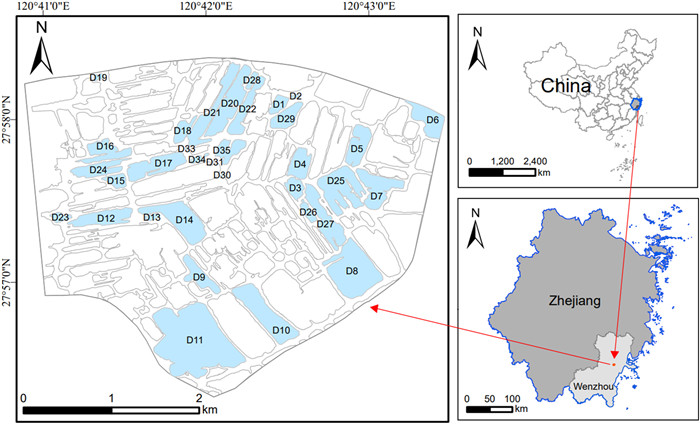
|
| Fig. 1 The 35 studied islands (blue color) and the location of the Sanyang Wetland in Wenzhou City, Zhejiang Province, China. |
We chose 35 sample islands that covered a gradient of island area distribution (0.056–48.979 ha) and isolation across islands (Liu et al., 2023b). These islands were formed naturally but are now influenced by human activities such as cultivation, tourism, and construction. Most parts of the islands are covered by Citrus reticulata cv. 'Suavissima', Celtis sinensis Pers., and Ficus concinna Miq, alongside invasive plant species like Solidago canadensis L., Bidens frondosa L. Ageratum conyzoides L., and Alternanthera philoxeroides (Mart.) Griseb.
2.2. Plant surveysIn 2021, we compiled presence-absence data of plants, including wild and cultivated native plants (non-invasive), and invasive plants across 35 surveyed islands. The incidence of species was determined through multiple comprehensive field visits (including spring and autumn) to selected islands until no additional plant species were found. The species accumulation curve showed that the surveys were adequate, thus creating a complete list of plant species for each island (Liu et al., 2023b). Invasive plant species were categorized based on datasets of alien plants in China (Lin et al., 2022) and a checklist of alien invasive plants of China (Ma and Li, 2018; Hao and Ma, 2023). Of 73 alien invasive plant species identified, only four species were lianas (i.e., Ipomoea quamoclit L., I. nil L., I. triloba L., and Cuscuta campestris Yuncker), and two cultivated woody plants (i.e., Acacia mearnsii De Wilde and Lantana camara L.); the remaining 67 invasive species were herbs. Therefore, only native (non-invasive) and invasive herbaceous species were included in subsequent analyses.
The dispersal modes of invasive herbaceous species were defined based on morphological adaptations of diaspores for long-distance dispersal, categorized as: (a) wind-dispersed species or anemochore species (e.g., diaspores with plumes and wings or dust diaspores); (b) animal-dispersed species or zoochore species (e.g., fleshy fruits or adhesive barbs); (c) gravity-dispersed species or autochore species (e.g., diaspores with morphological adaptations for short-distance dispersal only, such as ballochory and myrmecory); (d) water-dispersed species or hydrochory species (i.e., propagule is carried by water); (e) unspecialized species (no evident or prevalent morphological adaptations) (Mologni et al., 2022; Walentowitz et al., 2022). Because only four species were defined as hydrochory and no species was defined as unspecialized species, we did not consider these dispersal modes in the following analysis.
2.3. Island attributes and human activitiesThe islands area (ha), distance to the nearest island (ND, m) and the nearest distance to the mainland (MD, m) were calculated through manually delineating islands from SPOT-6 satellite imagery (pansharpened and orthorectified in natural color) with a spatial resolution of 1.5 m (using ArcGIS 10.4), followed by application of FRAGSTATS 4.2 to ensure accuracy (McGarigal et al., 2015) (Table S1).
Habitat heterogeneity was assessed using the Shannon index of each island, which reflects the diversity of land use types (i.e., miscellaneous grass and waste grounds, orchards or farmland, forests, shrublands, artificial grasslands, greenhouses, and construction lands). The Shannon index (H') was calculated as
All analyses were conducted using R v.4.2.1 (R Core Team, 2023). The number of occurrence islands for each invasive species was recorded, and ANOVA was performed to compare the number of occurrence islands between anemochore, autochore, and zoochore species.
The relationship between the number of wild native herbaceous species and island attributes (i.e., island area, MD, and ND) was analyzed as a comparison with invasive herbaceous species. The power model was employed to examine the impact of island attributes on both number of wild native and invasive species. The power model fitting formula is as follows:
| (1) |
where x represents the island area or isolation (MD and ND), z represents the slope of the model, and logc represents the intercept of the model. Linear regression was also utilized to assess the relationships of habitat heterogeneity and the proportion of road area with the number of wild native species and invasive species. We tested the difference in the slope (i.e., z value) of linear regressions between wild native and alien invasive species using ANCOVA. We further calculated pairwise Sorensen indices to assess compositional dissimilarity (beta diversity) separately for wild native and invasive species across all island pairs using "beta.pair()" function in the betapart package (Baselga and Orme, 2012). The paired t-test was then used to test for a difference in compositional dissimilarity between wild native and invasive species.
Linear regression was used to test the relationships of the number of wild native herbaceous species and the number of cultivated native herbaceous species with the number of all, zoochore, autochore species, and anemochore invasive species. Additionally, linear regression was utilized to assess the relationships between the number of zoochore, autochore species, and anemochore invasive species with island attributes, habitat heterogeneity, and proportion of road area. The number of zoochore species was added by one as its was 0 in one of the study islands.
Generalized linear models (GLMs) with a logarithmic function as the default linking function for the Poisson distribution were employed to further evaluate the effects of island area, isolation, habitat heterogeneity, and proportion of road area on the number of all invasive species and those with each type of dispersal syndromes. In GLMs, island area, MD, and ND were log-transformed and then all predictors were standardized to a mean of 0 and a standard deviation of 1 (i.e., standardized regression coefficients), to compare the strength of each predictive factor. Model selection was based on the Second-order Akaike Information Criterion (AICc, corrected AIC for small samples) using the "dredge()" function and "get.models()" function in the Multi Model Inference (MuMIN) package (Barton, 2022; Burnham and Anderson, 2002), and multicollinearity between explanatory variables (i.e., island area, MD, ND, habitat heterogeneity, and proportion of road area) was assessed using variance inflation factors (VIFs). The VIFs test results indicate that the VIFs values of all variables in the model are less than 10, indicating that multicollinearity did not affect the results. All fitted models underwent validation for normality and homoscedasticity using the DHARMa package by plotting a QQ plot of the residuals and plotting residuals against fitted values (Hartig, 2022).
To test the effect of island attributes and human activities on composition of invasive species between islands, the relationships between species composition and predictors (i.e., island area, habitat heterogeneity, proportion of road area, MD, and ND) were assessed using distance-based redundancy analysis (dbRDA) with Bray–Curtis dissimilarity. The individual effect of each factor (as determined by hierarchical partitioning) was examined by rdacca.hp package (Lai et al., 2022). The individual effect is used to compare the difference in the proportion of response variables explained between explanatory variables (relative importance). The number of zoochore species on one of the study islands was 0, so we did not consider this island in the dbRDA.
3. ResultsA total of 67 invasive herbaceous species from 26 families and 51 genera were recorded across the 35 islands in the Sanyang Wetland, including 12 zoochore species, 19 anemochore species, 32 autochore species, and 4 hydrochory species (Table S2). The number of all, zoochore, anemochore, and autochore invasive species per island ranged from 5 to 27, 0 to 6, 2 to 10, and 1 to 11, respectively. Notably, species such as Alternanthera philoxeroides, Bidens pilosa, and Erigeron canadensis L. were prevalent, with A. philoxeroides recorded on 34 islands, and both B. pilosa and E. canadensis on 30 islands (Fig. S1). No significant difference was observed in the number of occurrence islands per species between autochore, zoochore, and anemochore species (Fig. S1).
Consistent with expectations, we detected a positive correlation between island area and the number of wild native (z = 0.247, R2 = 0.538, P < 0.001) and invasive species (z = 0.107, R2 = 0.222, P = 0.004), although this correlation was stronger the for wild native species than for invasive species (Fig. 2a; ANCOVA test: P = 0.011). Additionally, we found that the number of wild native species was negatively correlated with both MD (z = −0.206, R2 = 0.225, P = 0.004) and ND (z = −0.259, R2 = 0.227, P = 0.004); in contrast, the relationship between invasive species and these factors was very weak and not significant (Fig. 2b and c). Higher habitat heterogeneity and higher proportion of road area were associated with larger numbers of both wild native and invasive species (Fig. 2d and e). Additionally, species composition between islands was more similar for invasive species than for wild native species (Fig. 3).
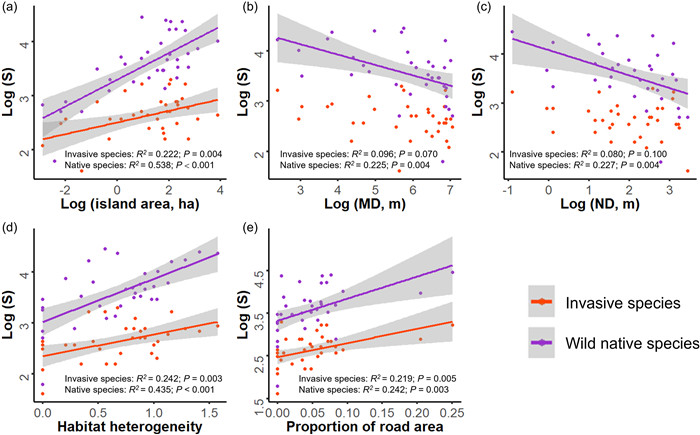
|
| Fig. 2 Relationships between the number of invasive and wild native herbaceous species and (a) island area, (b) distance to the mainland (MD), (c) distance to the nearest island (ND), (d) habitat heterogeneity, and (e) proportion of road area for the 35 islands in the Sanyang Wetland. The gray areas represent 95% confidence intervals of the linear regression models. Non-significant linear relationships are not shown. |
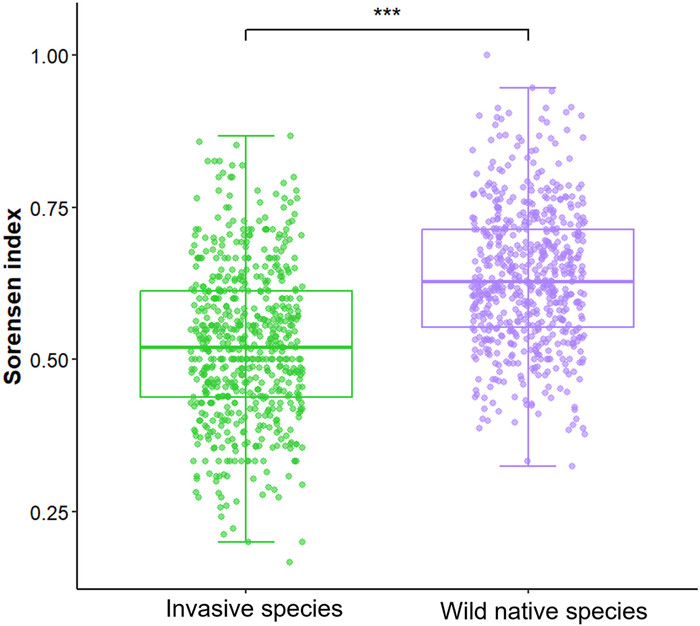
|
| Fig. 3 Differences in compositional dissimilarity (Sorensen index) across islands between invasive and wild native species. ∗∗∗P < 0.001. |
We observed a strong positive relationship between invasive species richness and both wild and cultivated native species richness on islands (wild: Fig. 4a, R2 = 0.638; P < 0.001; cultivated: Fig. 4b, R2 = 0.432; P < 0.001). This positive relationship with native species was also true for autochore, zoochore, and anemochore invasive species (Fig. 4c and d).
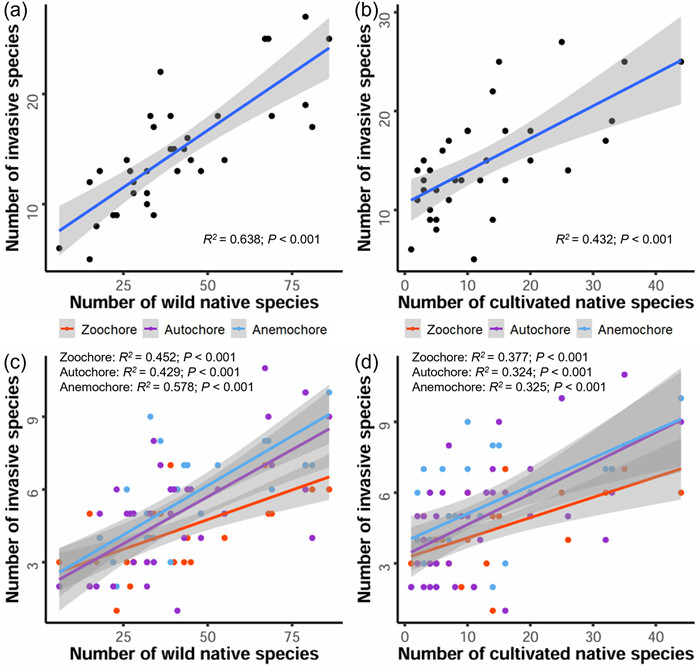
|
| Fig. 4 Relationships between the number of invasive herbaceous species and the number of (a) wild native and (b) cultivated native herbaceous species, and relationships between the number of zoochore (red), autochore (purple), and anemochore invasive species (blue) and the number of (c) wild and (d) cultivated native herbaceous species. The gray areas represent the 95% confidence interval of the linear regression models. |
We observed that island attributes and human activities differentially affected invasive species with different dispersal syndromes (Table 1; Fig. 5). Specifically, island area and proportion of road area were positively correlated with the number of autochore species. Habitat heterogeneity was positively correlated with the number of zoochore species. The proportion of road area was positively correlated with the number of anemochore species (Table 1; Fig. 5).
| Estimate | Std. Error | z-value | Pr (> |z|) | |
| Zoochore species | ||||
| Habitat heterogeneity | 0.172 | 0.083 | 2.057 | 0.040 |
| Anemochore species | ||||
| Proportion of road area | 0.138 | 0.067 | 2.077 | 0.038 |
| Habitat heterogeneity | 0.140 | 0.078 | 1.790 | 0.073 |
| Autochore species | ||||
| Island area | 0.219 | 0.088 | 2.473 | 0.013 |
| Proportion of road area | 0.148 | 0.068 | 2.186 | 0.029 |
| Note: In GLMs, the number of invasive species of zoochore species, anemochore species, and autochore species were response variables, and five variables (island area, MD: distance from mainland, ND: distance from nearest island, habitat heterogeneity, and proportion of road area to island area) were explanatory variables. All explanatory variables are normalized with a mean of zero and a standard deviation of 1. Only the variables retained in the best model with the lowest AICc are shown. | ||||
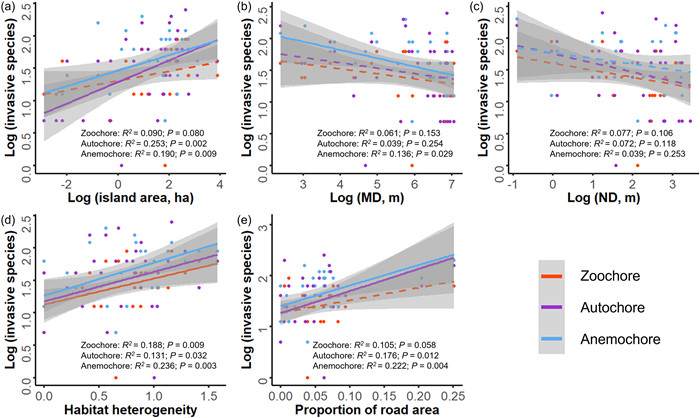
|
| Fig. 5 Relationships between the number of Zoochore, Autochore, and Anemochore species and (a) island area, (b) distance to the mainland (MD), (c) distance to the nearest island (ND), (d) habitat heterogeneity, and (e) proportion of road area for the 35 islands in the Sanyang Wetland. The gray areas represent the 95% confidence interval of the linear regression models. |
Hierarchical partitioning analysis indicated that the most important factor shaping invasive species composition across islands (Fig. 6a) and zoochore invasive species individually (Fig. 6b), is habitat heterogeneity. The most important factor influencing composition of anemochore invasive species is ND (Fig. 6c). No failed to identify factors that significantly affect composition of autochore invasive species (Fig. 6d).
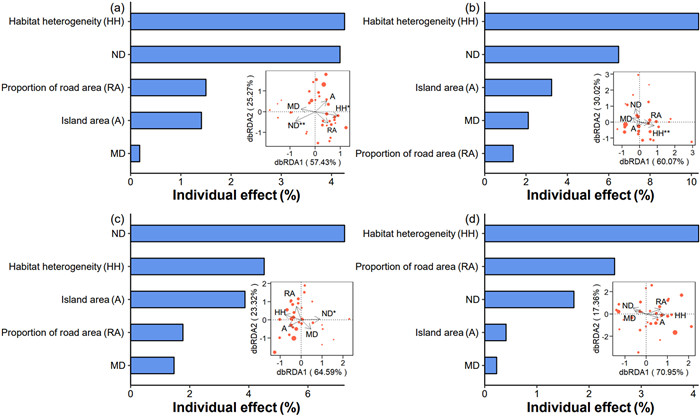
|
| Fig. 6 The relative importance of island area (A), distance to the mainland (MD), distance to the nearest island (ND), proportion of road area (RA), and habitat heterogeneity (HH) in predicting composition of (a) all, (b) zoochores, (c) anemochore, and (d) autochore invasive herbaceous species using hierarchical partitioning analysis. The subplot in each plot illustrates the relationship between species composition and predictors as assessed by distance-based redundancy analysis (dbRDA) based on Bray–Curtis dissimilarity. The dot size in the subplot indicates the size of island area. Asterisks indicate the significance predictor factors (∗P ≤ 0.05; ∗∗P ≤ 0.01). |
Invasive species can significantly impact native species communities (Peller and Altermatt, 2024). Identifying environmental factors that influence their dispersal and colonization—such as habitat isolation, local species diversity, and human activities (e.g., land use types and population movement)—is crucial for the prevention and management of alien species invasions (Dimitrakopoulos et al., 2022; Liu et al., 2023a; Rojas-Sandoval et al., 2020). Our findings indicate that increasing island area and habitat heterogeneity promote invasive species richness, whereas isolation had no significant effect. Additionally, we identified variations in the relative importance of island attributes and human activities on species number and composition on invasive plants with different dispersal syndromes.
According to the island biogeography theory, species diversity increases with the increase in island area and decreases with the increase in isolation (MacArthur and Wilson, 1967). Our study reveals that the relationships between the number of wild native species and island attributes are consistent with predictions of the island biogeography theory, but such relationships for invasive species are not (Fig. 2). Notably, there was no significant correlation between the number of invasive species and isolation, indicating that isolation between islands does not affect the diversity of invasive species. This finding for native and invasive species is similar to results obtained from other studies on islands or other fragmented habitats (Burns, 2015; Rojas-Sandoval et al., 2020). Previous studies have found that island characteristics (e.g., island area and isolation) primarily affect native species richness, whereas human-related factors mainly influence the number of invasive species richness (Rojas-Sandoval et al., 2020; Dimitrakopoulos et al., 2022; Rodgers and Parker, 2003). We observed that the slope (i.e., z-value) of the linear relationship between the number of invasive species and island area was smaller than the slope of the relationship between the number of wild native species and island area, indicating a lower turnover rate in invasive species as island area increases. These results suggest that invasive species are relatively common on islands, with higher composition similarity (i.e., lower z value) between islands (Fig. 3). This similarity in composition may be attributed to the stronger dispersal, colonization, and competition abilities of invasive species compared to native species, coupled with human activities to further promote their dispersal and colonization across islands.
We also found that increasing habitat heterogeneity increased both wild native and invasive species diversity. This finding supports the habitat heterogeneity hypothesis, which states that an increase in habitat heterogeneity within a landscape enhances species diversity through niche partitioning (Gramer and Willig, 2005). The rise in land use types due to human activities has also increased habitat heterogeneity in the Sanyang Wetland (Liu et al., 2023b), thereby providing more ecological niches for both naive and invasive species. Specifically, land-use types with less dense canopies and landscapes with reduced forest cover could facilitate the spread of invasive plants (Raveloaritiana et al., 2024). In addition, we found a higher proportion of road area within the island promotes both wild native and invasive species diversity. The proportion of road area is typically associated with increased visitor flow within islands, enhancing connectivity, edge effects or disturbance on islands, thereby promoting the dispersal and colonization of species.
Consistent with our expectations, we found a positive correlation between wild native species richness and invasive species richness (Fig. 4a). This result does not support the biotic resistance hypothesis (Elton, 1958). Similarly, Rojas-Sandoval et al. (2020) reported a strong positive correlation between native and invasive species richness on islands across the Lesser Antilles. The positive correlation has also been found at a large scale (Peng et al., 2019), and is often attributed to ecological processes simultaneously acting on both native and invasive species. This result suggests that island area, habitat heterogeneity, and proportion of road area favoring a high number of native species may also increase niche opportunities for invasive species. In addition, we found a positive correlation between the number of cultivated native species and the number of invasive species on islands (Fig. 4b). Plant cultivation may not only promote the dispersal of invasive species but also provide more niches for the coexistence of invasive species, thereby offering more opportunities for deliberate and accidental introduction of invasive species.
Plant functional traits related to dispersal ability can influence invasion success of invasive species on islands (Mologni et al., 2022; Zhang et al., 2023). Although habitat heterogeneity, island area, and proportion of road area positively affect the number of invasive species on islands (Fig. 2), their relative importance varies among invasive species with different dispersal syndromes (Table 1). Apart from differences in dispersal ability, these results may also be related to the adaptation of different dispersal syndromes to various environmental factors. For example, habitat heterogeneity was found to predominantly positively affect the number of zoochore invasive species, whereas island area and proportion of road area were found to significantly affect the number of autochore invasive species, with the proportion of road area having a significant impact on the number of anemochore invasive species (Table 1; Fig. 5).
Invasive species dispersed by wind and animals could be recognized to have long-distance dispersal ability (Vittoz and Engler, 2008; Arjona et al., 2018). Here, isolation between islands did not significantly affect the number of anemochore and zoochore invasive species, whereas the distance to the nearest island affected composition of the anemochore invasive species (Fig. 6). Although anemochore invasive species exhibit high invasiveness on islands due to their high dispersal ability, the distance to the nearest island could filter the composition of anemochore species, possibly because the nearest island acts as a stepping-stone island (Larrue et al., 2015). Additionally, higher habitat heterogeneity increases the ecological niche of plants and influences the distribution and quantity of animals in different habitat types, such as frugivores (Kim et al., 2022), thereby increasing the number of zoochore invasive species in this study (Table 1). Furthermore, we found that habitat heterogeneity was the most significant factor influencing differences in species composition of zoochore invasive species between islands (Fig. 6), indicating that habitat heterogeneity not only increases the number of zoochore species but also results in different zoochore species compositions in different habitats. As for autochore species, their limited dispersal ability enables them to spread only short distance by themself. However, we found that island area and proportion of road area, rather than isolation (distance to the mainland and distance to the nearest island), significantly affected the number and composition of autochore invasive species. This finding can arise if dispersal is very low even among nearby islands, or if dispersal is effectively "global, " connecting all islands equally (Liu et al., 2018). Here, we are inclined to support the very low dispersal of autochore species among nearby islands due to their limited dispersal ability. The proportion of road area, related to a higher flow of visitors within islands and connectivity, mainly promotes the dispersal and colonization of anemochore and autochore invasive species.
We conclude that habitat fragmentation influences invasive and native plant diversity in different ways. The relationship between species diversity and island attributes aligns with the equilibrium theory of island biogeography for native species, but not for invasive species. Our findings also indicate that the diversity and composition of invasive species, depending on their dispersal syndromes, are influenced by different fragment attributes. Customizing habitat management and regulating human activities could be effective strategies for mitigating the spread of invasive species in fragmented landscapes.
AcknowledgmentsWe are very grateful to Mengsi Zhou, Dan Long, Xiaowen Jia, Yunfan Hu in Wenzhou University for field work. We also thank Prof. Renyong Hu for identification of species. We thank Wenzhou Ecological Park for the permits necessary to conduct our research in Sanyang Wetland. This study was supported by the National Key R&D program (2023YFE0124900), the National Natural Science Foundation of China (32271606), and the Research Project of Wenzhou Ecological Park Management Committee (SY2022ZD- 1001-03).
Data availability
The data that support the findings of this study is available in the supporting information.
CRediT authorship contribution statement
Jinliang Liu: Writing – original draft, Investigation, Formal analysis, Conceptualization. Mengyuan Chen: Writing – original draft, Investigation, Formal analysis. Lu Wang: Investigation. Tengteng Liu: Investigation. Xinjie Jin: Investigation. Fei-Hai Yu: Writing – original draft. Yonghua Zhang: Writing – review & editing, Investigation.
Declaration of competing interest
The authors declare that they have no known competing financial interests or personal relationships that could have appeared to influence the work reported in this paper.
Appendix A. Supplementary data
Supplementary data to this article can be found online at https://doi.org/10.1016/j.pld.2024.09.003.
Arjona, Y., Nogales, M., Heleno, R., et al., 2018. Long-distance dispersal syndromes matter: diaspore–trait effect on shaping plant distribution across the Canary Islands. Ecography, 41: 805-814. DOI:10.1111/ecog.02624 |
Bacles, C.F., Lowe, A.J., Ennos, R.A., 2006. Effective seed dispersal across a fragmented landscape. Science, 311: 628. DOI:10.1126/science.1121543 |
Baselga, A., Orme, C.D.L., 2012. betapart: an R package for the study of beta diversity. Methods Ecol. Evol., 3: 808-812. DOI:10.1111/j.2041-210X.2012.00224.x |
Barton, K., 2022. MuMIn: multi-model inference. R Package Vers., 1.47.41. |
Burnham, K.P., Anderson, D.R., 2002. Model Selection and Multi-Model Inference: a Practical Information Theoretic Approach. Springer..
|
Burns, K.C., 2015. A theory of island biogeography for exotic species. Am. Nat., 186: 441-451. DOI:10.1086/682934 |
Dimitrakopoulos, P.G., Koukoulas, S., Michelaki, C., et al., 2022. Anthropogenic and environmental determinants of alien plant species spatial distribution on an island scale. Sci. Total Environ., 805: 150314. DOI:10.1016/j.scitotenv.2021.150314 |
Elton, C.S., 1958. The Ecology of Invasions by Plants and Animals. Methuen, London: Methuen Publishing Ltd..
|
Gioria, M., Hulme, P.E., Richardson, D.M., et al., 2023. Why are invasive plants successful?. Annu. Rev. Plant Biol., 74: 635-670. DOI:10.1146/annurev-arplant-070522-071021 |
Gramer, M.J., Willig, M.R., 2005. Habitat heterogeneity, species diversity and null models. Oikos, 108: 209-218. DOI:10.1111/j.0030-1299.2005.12944.x |
Guo, Q., 2014. Species invasions on islands: searching for general patterns and principles. Landsc. Ecol., 29: 1123-1131. DOI:10.1007/s10980-014-0059-2 |
Haddad, N.M., Brudvig, L.A., Clobert, J., et al., 2015. Habitat fragmentation and its lasting impact on Earth's ecosystems. Sci. Adv., 1: e1500052. DOI:10.1126/sciadv.1500052 |
Hao, Q., Ma, J.S., 2023. Invasive alien plants in China: an update. Plant Divers., 45: 117-121. DOI:10.1016/j.pld.2022.11.004 |
Hartig, F., 2022. DHARMa: residual diagnostics for hierarchical (multi-level/mixed) regression models. R package version 0.4.6.
|
Jeschke, J.M., Debille, S., Lortie, C.J., 2018. Invasion biology: hypotheses and evidence. In: Jeschke, J.M., Heger, T. (Eds. ), Biotic Resistance and Island Susceptibility Hypotheses. CAB International, Wallingford, UK, pp. 60-70.
|
Kim, S., Sales, L., Carreira, D., et al., 2022. Frugivore distributions are associated with plant dispersal syndrome diversity in the Caribbean archipelagos. Divers. Distrib., 28: 2521-2533. DOI:10.1111/ddi.13503 |
Lai, J., Zou, Y., Zhang, J., et al., 2022. Generalizing hierarchical and variation partitioning in multiple regression and canonical analyses using the rdacca. hp R package. Meth. Ecol. Evol., 13: 782-788. DOI:10.1111/2041-210x.13800 |
Larrue, S., Butaud, J. -F., Dumas, P., et al., 2015. Native plant species richness on Eastern Polynesia's remote atolls. Prog. Phys. Geogr., 40: 112-134. DOI:10.1177/0309133315615804 |
Lin, Q., Xiao, C., Ma, J., 2022. A dataset on catalogue of alien plants in China. Biodivers. Sci., 30: 22127. DOI:10.17520/biods.2022127 |
Liu, D., Semenchuk, P., Essl, F., et al., 2023a. The impact of land use on non-native species incidence and number in local assemblages worldwide. Nat. Commun., 14: 2090. DOI:10.1038/s41467-023-37571-0 |
Liu, J., Liu, T., Zhou, Y., et al., 2023b. Plant diversity on islands in the Anthropocene: integrating the effects of the theory of island biogeography and human activities. Basic Appl. Ecol., 72: 45-53. DOI:10.1016/j.baae.2023.07.006 |
Liu, J., Vellend, M., Wang, Z., et al., 2018. High beta diversity among small islands is due to environmental heterogeneity rather than ecological drift. J. Biogeogr., 45: 2252-2261. DOI:10.1111/jbi.13404 |
Liu, Y.Y., Sun, Y., Muller-Scharer, H., et al., 2019. Do invasive alien plants differ from non-invasives in dominance and nitrogen uptake in response to variation of abiotic and biotic environments under global anthropogenic change?. Sci. Total Environ., 672: 634-642. DOI:10.1016/j.scitotenv.2019.04.024 |
Ma, J., Li, H., 2018. The Checklist of the Alien Invasive Plants of China. Beijing: Higher Education Press.
|
Ma, J., Li, J., Wu, W., et al., 2023. Global forest fragmentation change from 2000 to 2020. Nat. Commun., 14: 3752. DOI:10.1038/s41467-023-39221-x |
MacArthur, R.H., Wilson, E.O., 1967. The Theory of Island Biogeography. Princeton, New Jersey, USA: Princeton University Press.
|
Mologni, F., Bellingham, P.J., Cameron, E.K., et al., 2022. Functional traits explain non-native plant species richness and occupancy on northern New Zealand islands. Biol. Invasions, 24: 2135-2154. DOI:10.1007/s10530-022-02762-1 |
Mologni, F., Bellingham, P.J., Tjørve, E., et al., 2021. Similar yet distinct distributional patterns characterize native and exotic plant species richness across northern New Zealand islands. J. Biogeogr., 48: 1731-1745. DOI:10.1111/jbi.14110 |
Moody, A., 2000. Analysis of plant species diversity with respect to island characteristics on the Channel Islands, California. J. Biogeogr., 27: 711-723. DOI:10.1046/j.1365-2699.2000.00435.x |
Peller, T., Altermatt, F., 2024. Invasive species drive cross-ecosystem effects worldwide. Nat. Ecol. Evol., 8: 1087-1097. DOI:10.1038/s41559-024-02380-1 |
Peng, S., Kinlock, N.L., Gurevitch, J., et al., 2019. Correlation of native and exotic species richness: a global meta-analysis finds no invasion paradox across scales. Ecology, 100: e02552. DOI:10.1002/ecy.2552 |
Raveloaritiana, E., Tscharntke, T., Martin, D.A., et al., 2024. Land-use intensity and relatedness to native plants promote exotic plant invasion in a tropical biodiversity hotspot. J. Appl. Ecol., 61: 1396-1410. DOI:10.1111/1365-2664.14657 |
Rodgers, J.C., Parker, K.C., 2003. Distribution of alien plant species in relation to human disturbance on the Georgia Sea Islands. Divers. Distrib., 9: 385-398. DOI:10.1046/j.1472-4642.2003.00036.x |
Rojas-Sandoval, J., Ackerman, J.D., Tremblay, R.L., et al., 2020. Island biogeography of native and alien plant species: contrasting drivers of diversity across the Lesser Antilles. Divers. Distrib., 26: 1539-1550. DOI:10.1111/ddi.13139 |
Russell, J.C., Kueffer, C., 2019. Island biodiversity in the anthropocene. Annu. Rev. Environ. Resour., 44: 31-60. DOI:10.1146/annurev-environ-101718-033245 |
Schmack, J.M., Schleuning, M., Ward, D.F., et al., 2020. Biogeography and anthropogenic impact shape the success of invasive wasps on New Zealand's offshore islands. Divers. Distrib., 26: 441-452. DOI:10.1111/ddi.13021 |
Storch, D., Šímová, I., Smyčka, J., et al., 2022. Biodiversity dynamics in the Anthropocene: how human activities change equilibria of species richness. Ecography, 2022: e05778. DOI:10.1111/ecog.05778 |
Vellend, M., Baeten, L., Becker-Scarpitta, A., et al., 2017. Plant biodiversity change across scales during the Anthropocene. Annu. Rev. Plant Biol., 68: 563-586. DOI:10.1146/annurev-arplant-042916-040949 |
Vila, M., Espinar, J.L., Hejda, M., et al., 2011. Ecological impacts of invasive alien plants: a meta-analysis of their effects on species, communities and ecosystems. Ecol. Lett., 14: 702-708. DOI:10.1111/j.1461-0248.2011.01628.x |
Vilà, M., Trillo, A., Castro-Díez, P., et al., 2024. Field studies of the ecological impacts of invasive plants in Europe. NeoBiota, 90: 139-159. DOI:10.3897/neobiota.90.112368 |
Vittoz, P., Engler, R., 2008. Seed dispersal distances: a typology based on dispersal modes and plant traits. Bot. Helv., 117: 109-124. DOI:10.1007/s00035-007-0797-8 |
Walentowitz, A., Troiano, C., Christiansen, J.B., et al., 2022. Plant dispersal characteristics shape the relationship of diversity with area and isolation. J. Biogeogr., 49: 1599-1608. DOI:10.1111/jbi.14454 |
Wang, Y.J., Liu, Y.Y., Chen, D., et al., 2024. Clonal functional traits favor the invasive success of alien plants into native communities. Ecol. Appl., 34: e2756. DOI:10.1002/eap.2756 |
Wang, Y.J., Muller-Scharer, H., van Kleunen, M., et al., 2017. Invasive alien plants benefit more from clonal integration in heterogeneous environments than natives. New Phytol., 216: 1072-1078. DOI:10.1111/nph.14820 |
Wohlwend, M.R., Craven, D., Weigelt, P., et al., 2021. Anthropogenic and environmental drivers shape diversity of naturalized plants across the Pacific. Divers. Distrib., 27: 1120-1133. DOI:10.1111/ddi.13260 |
Zhang, B., Hastings, A., Grosholz, E.D., et al., 2023. The comparison of dispersal rate between invasive and native species varied by plant life form and functional traits. Mov. Ecol., 11: 73. DOI:10.1186/s40462-023-00424-y |
Zhu, C., Dalsgaard, B., Li, W., et al., 2023. Generalist and topologically central avian frugivores promote plant invasion unequally across land-bridge islands. Ecology, 105: e4216. DOI:10.1002/ecy.4216 |



